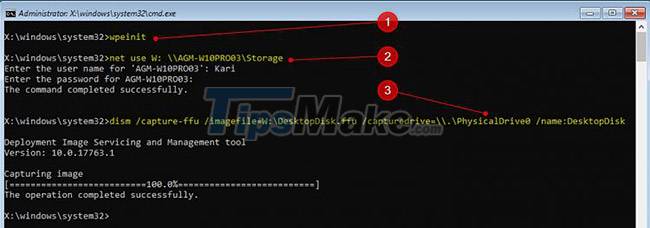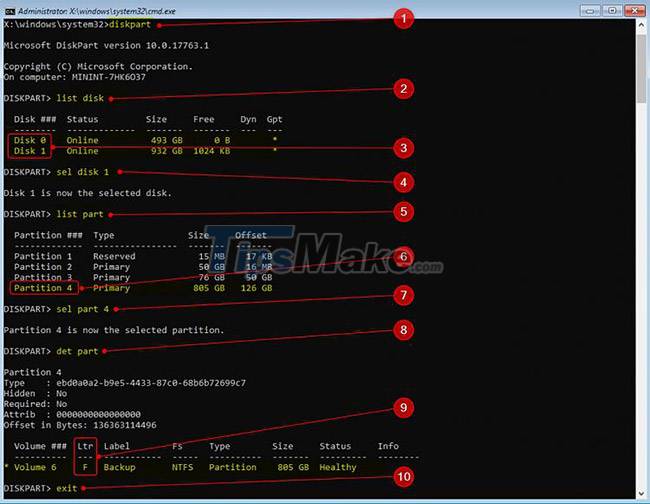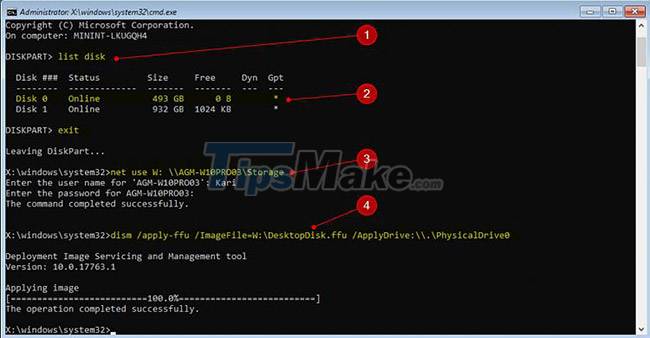How to use DISM to copy and restore images FFU
This means that while a WIM file can be applied to any hard drive or SSD capacity, an FFU image can only be applied (deployed) to drives of the same or larger capacity. captured disc. How much storage space is used or available on that drive only affects the size of the captured FFU image file.
Using DISM with FFU is also useful if you have to replace your HDD or SSD. Just take a FFU image, replace the drive and apply the image to the new drive. Image FFU is a 100% exact copy of the drive, sector by sector. Capturing and deploying FFU images is quick, in fact much faster than using any third-party software.
In this tutorial, Tipsmake will demonstrate how to capture and deploy an FFU image using DISM.
Please note : FFU images can only be created from a GPT-formatted drive. Similarly, it can only be deployed on GPT drives. Image FFU does not work with MBR formatted drives.
1. Create WinPE ISO or USB
1.1. Although it is possible to create FFU images since version 1709, Windows 10 DISM cannot capture or apply FFU images:

1.2. To capture and apply an FFU image, you will need to boot your computer or virtual machine from Windows PE media. See this guide for how to do it: Instructions to create WinPE IOS file, USB boot WinPE.
2. Take a FFU image to share over the network
2.1. Boot the computer or virtual machine you want to capture from WinPE.
2.2. Usually when copying a drive, the user cannot use it to store the copied image. In this case, the only option is to use network sharing.
2.3. When the WinPE Command Prompt starts, the wpeinit command will run to initialize and activate the network connection.
net use W: PC_NameShareNameThe drive letter W: in the above command is just a suggestion, you can use any unused character. When prompted, enter your username and password to access that share.
2.4. Enter the following command to capture Disk 0 (PhysicalDrive0) and share it over the network mapped as an FFU image file (.ffu extension):
dism /capture-ffu /imagefile=W:DesktopDisk.ffu /capturedrive=.PhysicalDrive0 /name:DesktopDisk 
The name of the captured FFU image can be anything you want, but the extension should be .ffu.
3. Capture FFU image to local drive
3.1. Booting into WinPE may display a different drive letter than what you normally see when booting normally with Windows. To make sure you're using the correct drive letter for the partition used to save the FFU image, you'll need DISKPART.
3.2. When WinPE Command Prompt is displayed, enter the following command to start Windows Disk Partitioning Utility:
diskpart3.3. Enter the following command to check the drive number for all connected internal and external hard drives:
list diskNote the drive number for both the drive you want to capture to the FFU image and the drive used to store the image file. In this example, the author of the article will capture disk 0 and save the image on disk 1.
3.4. Select the drive where the image will be saved with the following command, replacing # with the actual drive number:
sel disk #3.5. Check the available partitions on the selected drive with the following command:
list part3.6. In the case of this example, the author will save to Partition 4. Select it with the following command:
sel part 43.7. To get its drive letter, check the partition details with the following command:
det partThe author notes the drive letter under the Ltr column. In the example case, the captured FFU image will be saved to the F: drive.
3.8. Exit DISKPART with the following command:
exit 
3.9. Capture the drive to an FFU image with the following command:
dism /capture-ffu /imagefile=F:DesktopDisk.ffu /capturedrive=.PhysicalDrive0 /name:DesktopDisk 
In this example, the above command captures disk 0 (PhysicalDrive0) to drive F: as DesktopDisk.ffu file.
4. Apply the FFU . image
4.1. Boot from WinPE
4.2. Check the drive number you want to apply the image. If the image will be applied from the local drive, check the lettering for the partition where the image is saved. See steps 3.2 to 3.9 for how to use DISKPART for this.
4.3. In this example case, the author will apply an image from the network share, containing the image. That sharing mapping is shown in step 2.3.
4.4. The author will apply the DesktopDisk.ffu FFU image from the W: mapped share to disk 0 with the following command:
dism /apply-ffu /ImageFile=W:DesktopDisk.ffu /ApplyDrive:.PhysicalDrive0 
An identical sector-by-sector copy image has been applied to the drive. Booting the PC from that drive, Windows will be exactly the same as when the image was taken, except Windows needs to be reactivated if the image applies to a different machine than the one it was captured on and the new machine doesn't have a digital license now available.
You should read it
- 4 ways to fix DISM error 87 on Windows 10/11
- How to convert ESD files to WIM using DISM on Windows 10
- How to install CAB files for updates and drivers on Windows 10
- How to backup and restore Windows 10 from System Image
- How to backup and restore Windows in just 10 minutes with Acronis True Image
- How to Resize an Image in Microsoft Paint
- How to Crop an Image Using GIMP
- Border Image - Create image borders in CSS
May be interested
- How to Recover Deleted Photos
 this article will show you how to recover deleted photos on your computer, smartphone or tablet. remember that unless you restore images immediately after deletion, some images will be unrecoverable.
this article will show you how to recover deleted photos on your computer, smartphone or tablet. remember that unless you restore images immediately after deletion, some images will be unrecoverable. - Reg command copy in Windows
 to copy an entry to the location specified on the local pc or the remote computer we will use the reg copy command. to learn more about how to use the reg copy command, you can track the syntax, explain the command parameters and the example tipsmake.com has compiled below.
to copy an entry to the location specified on the local pc or the remote computer we will use the reg copy command. to learn more about how to use the reg copy command, you can track the syntax, explain the command parameters and the example tipsmake.com has compiled below. - Macromedia Flash - Automatically copy images in flash workspace
 in this article, i will show you how to import any image into the flash workspace and then copy it multiple times using a small piece of code.
in this article, i will show you how to import any image into the flash workspace and then copy it multiple times using a small piece of code. - Instructions on how to use System Restore on Windows
 system restore is a tool available on the windows operating system, enabling users to restore windows state at a certain time, created by the user or by a specific computer.
system restore is a tool available on the windows operating system, enabling users to restore windows state at a certain time, created by the user or by a specific computer. - How to copy and paste on Mac
 copying and pasting is the basic action frequently used on computers. you just switched to a mac and don't know how to do this? please read the following article.
copying and pasting is the basic action frequently used on computers. you just switched to a mac and don't know how to do this? please read the following article. - Instructions to recover deleted WhatsApp messages and images on iPhone
 accidentally deleting whatsapp messages is a frequent occurrence, so whatsapp provides useful features to backup and restore iphone and ipad using ios 5/6/7/8 or ios operating system. 9. here are the steps to restore whatsapp chat history on iphone and ipad.
accidentally deleting whatsapp messages is a frequent occurrence, so whatsapp provides useful features to backup and restore iphone and ipad using ios 5/6/7/8 or ios operating system. 9. here are the steps to restore whatsapp chat history on iphone and ipad. - How to use System Restore in Windows: Turn off, turn on, create, restore System Restore
 system restore is a windows utility that allows users to restore the status of a window at a certain time. the time of recovery can be set by the computer or by the user. software, data from the time of restore are deleted.
system restore is a windows utility that allows users to restore the status of a window at a certain time. the time of recovery can be set by the computer or by the user. software, data from the time of restore are deleted. - How to backup and restore all Firefox data with Profile
 when we use firefox on many different computers and want them to have all the features that we previously installed on the original computer, we will force you to backup your data and restore them. on firefox the most common way to backup and restore is to copy the firefox data folder on your computer.
when we use firefox on many different computers and want them to have all the features that we previously installed on the original computer, we will force you to backup your data and restore them. on firefox the most common way to backup and restore is to copy the firefox data folder on your computer. - How to Backup and Restore data on iPhone, iPad
 how to backup and restore data on iphone, ipad. one drawback on apple mobile devices is that they do not support memory cards and we cannot copy data to a memory card and store it on our computer. however, there are ways to backup and restore data easily on iphone and ipad
how to backup and restore data on iphone, ipad. one drawback on apple mobile devices is that they do not support memory cards and we cannot copy data to a memory card and store it on our computer. however, there are ways to backup and restore data easily on iphone and ipad - Using Google Lens to convert images into words, find information easily
 google lens can copy text from books or documents without typing again, nor use the application to convert images into text. i have tested with the word in vietnamese and the results are extremely impressive.
google lens can copy text from books or documents without typing again, nor use the application to convert images into text. i have tested with the word in vietnamese and the results are extremely impressive.










 Will the performance of big.LITTLE x86 CPUs increase significantly on Windows 11?
Will the performance of big.LITTLE x86 CPUs increase significantly on Windows 11? How to return to Windows 10's Start menu on Windows 11
How to return to Windows 10's Start menu on Windows 11 Information about Microsoft's upcoming Windows 11 Operating System
Information about Microsoft's upcoming Windows 11 Operating System How to open CMD with Administrator rights on Windows
How to open CMD with Administrator rights on Windows How to restart Amazon Kindle, reset Amazon Kindle
How to restart Amazon Kindle, reset Amazon Kindle How to use Nearby Share on Chromebook
How to use Nearby Share on Chromebook